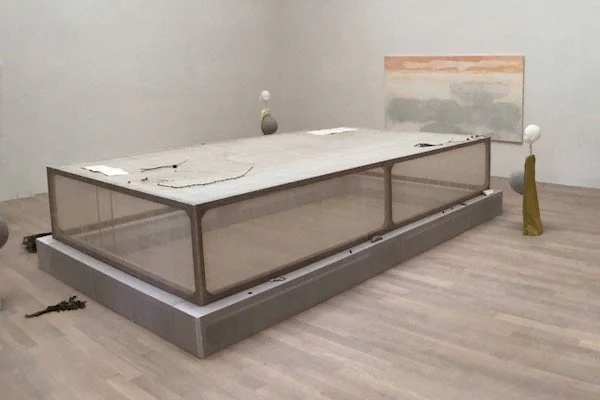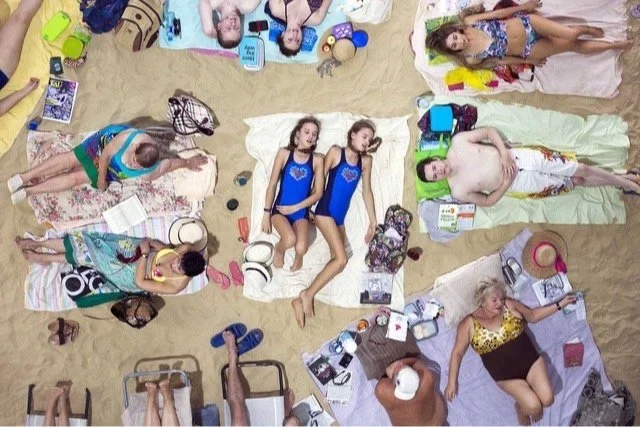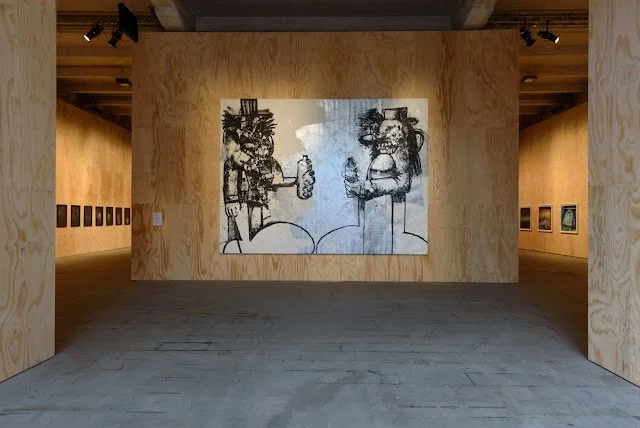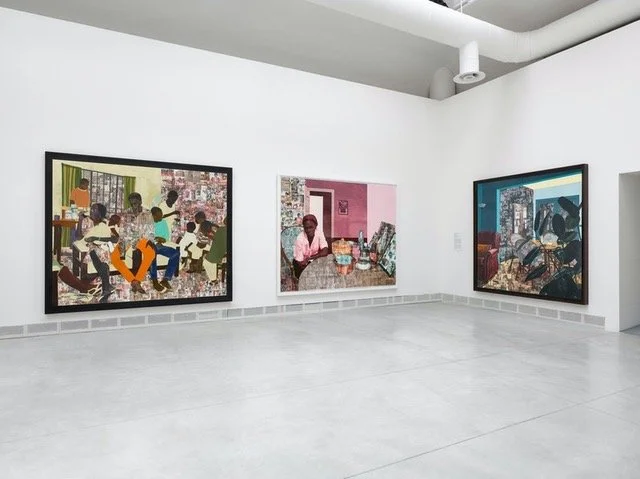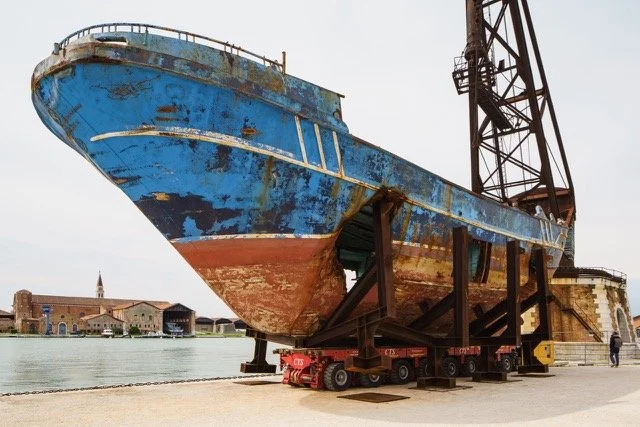Venice Biennale 2019 A Curators selection
Venice Biennale 2019 A Curators selection
This is a selection of shows I visited while curating an unofficial show in Venice. It is idiosyncratic, and as such based upon available time while involved in a complex project.
Cathy Wilkes hints. In her presentation for the British Pavilion, like previous shows, the selection, location and make up of individual works informs a whole. What that ‘whole’ might be is left, to a large extent, to the viewer. In previous exhibitions Wilkes suggests, by the inclusion of family memorabilia for instance, an autobiographical bent. But this is not mandated. An enjoyment of materiality, relationship between form and content allows for many readings. Here found objects are given as much authority as artworks made by Wilkes. These associations encourage multiple interpretations, and this is a richer and more important show because of it. It’s a dramatic contrast to the equally successful shows by Phyllida Barlow in 2017 and Sarah Lucas in 2015. For many years the British Pavilion at the International Art Exhibition - La Biennale di Venezia was exclusive to the British Council, curated and managed by them. It remains a British Council project but this year an invitational process was used for selection of a curator, and the first African-American woman, Zoé Whitley curated a British pavilion exhibition. This is a positive and welcome development that should have happened sooner.
Installation view, Cathy Wilkes, British Pavilion, Biennale Arte, Venice, 2019. © British Council. Courtesy the Artist, The Modern Institute/Toby Webster Ltd, Glasgow and Xavier Hufkens, Brussels
As with many national pavilions without a space in the Giardini (or allocated one in the Arsenale), Sun & Sea (Marina) directed by Rugilė Barzdžiukaitė, written by Vaiva Grainytė, and with music by Lina Lapelytė for the Lithuanian Pavilion was located well off the usual tourist routes in Venice. But it was well worth the challenge. An artificial beach in what seemed to be an old warehouse, hosts over twenty actors as part of a nine-hour opera. This fabulous if exhausting work won the Golden Lion at the Biennale for best national participation. The voyeurism made this viewer uncomfortable initially, but as the performance continued, this melted away, however, I could not help but think that the live installation worked as well, if not better (being even more ambiguous) as the audio work.
View of Sun & Sea (Marina), an opera at the Lithuanian Pavilion, 58th Venice Biennale, 2019. Courtesy of the artists
The first work seen in the Arsenale, welcoming you to its long journey is a large George Condo painting. Two Phillip Guston like figures, seem to be in the act of toasting something, perhaps you? There also seem to be two phallic symbols, make of that what you will. Condo, the ex-punk and printer for Warhol who studied Old Master glazing techniques is a great start to this extensive show. A series of installations by artists including Tavares Strachan, Shilpa Gupta, Jesse Darling and the incomparable Jimmie Durham enhance this view, though there has been some controversy of the decision to award a Golden Lion to Durham.
George Condo, Double Elvis, 2019, courtesy the artist, Skarstedt, New York and Sprüth Mahers, Berlin, London, Los Angeles
Njideka Akunyili Crosby’s resounding paintings are the high point of the Ralph Rugoff curated show, May You Live in Interesting Times, in the Giardini along with Arthur Jafa’s film installation, The White Album. Crosby’s layered and collaged paintings reflect upon the complexity of contemporary life, the impossibility of generalising about peoples, and a celebration of family and friends. Jafa’s work is an excoriating narrative on white supremacy using found online material, damning the authors with their own recordings. An unusual example of co-creation.
Installation view: 58th International Art Exhibition - La Biennale di Venezia, May You Live In Interesting Times, 2019, showing work by Njideka Akunyili Crosby. Courtesy Victoria Miro, and David Zwirner.
Banksy made an appearance with an unofficial artists’s stall, a series of paintings on easels, standing on a street, making up a whole image of an oligarch’s yacht overwhelming Venice architecture. A girl with torch graffiti work also appeared on a wall, just above the waters of a canal. Other significant ‘unofficial’ exhibitions include the extraordinary psalm by Edmund de Waal. One part hosted in the Jewish Museum made up of new installations of porcelain, marble and gold, aimed to animate the space, and bring new visitors to the Ghetto, a beautiful and private part of Venice, north of the station, that is not usually explored by Biennale visitors being so far away from the Giardini and Arsenale.
Co-creation is also present, strikingly so, with Cameron Jamie’s Smiling Disease from 2008 in the Arsenale, that the artist commissioned from Austrian crafts people.
However, Chrisopher Büchels, Barca Nostra, the recovered ship which sank with an estimated 1100 refugees aboard with only 28 accounted for afterwards and presented as part of the Arsenale show is deeply problematic. A white European artist appropriating the ship and presenting it as ‘his’ artwork, despite narratives around it as a ‘project’ and use as a ‘symbolic vehicle’, is not fully thought through. It seems gestural, in much the same way as Ai Wei Wei’s recreation of the body of three-year-old Aylan Kurdi was seen as opportunistic and thoughtless.
Christoph Büchel, Barca Nostra, 2018–19. Photo: Andrea Avezzù. Image courtesy La Biennale di Venezia.
Another collaboration, between Arts Council England and Delfina Foundation brought live art performance to the Biennale. The addition of performance is welcome, and the artists presented are high calibre practitioners. However, when ACE is insisting that international projects MUST have an output in England to justify funding, the lack of presenting this project in England is nothing less than a double standard. www.delfinafoundation.com/performance-programme-at-the-58th-venice-biennale/
Mark Segal is a curator and writer. He curated the exhibition, Natura Prima? Stephen Turner, The Eggman, Riverine Communities: Venice and Thamesmead (2019 - 2021), Istituzione Fondazione Bevilacqua La Masa and Bow Arts, London. He curated ArtSway’s official collateral events at the Venice Biennale in 2007, 2009 and 2011 and is a curator for Venice Agendas which regularly mounts events, discussions and artist commissions for Venice and England, including live performance.

